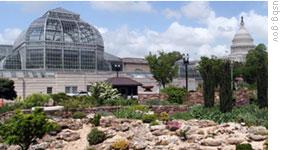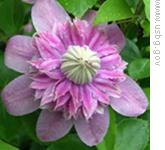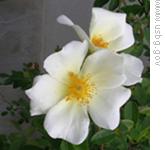VOA慢速英语-SCIENCE IN THE NEWS - Stopping to Smell the Roses, a
搜索关注在线英语听力室公众号:tingroom,领取免费英语资料大礼包。
(单词翻译)
VOICE ONE:This is SCIENCE IN THE NEWS in VOA Special English. I'm Bob Doughty1.
VOICE TWO:
And I'm Barbara Klein. This week on our program, we visit the United States Botanic Garden in Washington, D.C.
(MUSIC)
VOICE ONE:
The United States Botanic Garden is located on the grounds of the Capitol, the building where Congress meets. In fact, Congress operates the garden through the office of the Architect of the Capitol. The Botanic Garden is a museum alive with four thousand different plants from across America and the world.
 |
| Conservatory2 building at the U.S. Botanic Garden. At right is the dome3 of the Capitol. |
Visitors can explore the collection indoors, in the glass-and-stone building called the Conservatory, and also outdoors. Next to the Conservatory is the National Garden, which opened in two thousand six.
VOICE TWO:
The National Garden took five years to build. The project cost ten million dollars and was financed with private donations.
Visitors can enjoy wildflowers and roses -- the rose is the national flower -- along with beautiful stonework, fountains and pools. One area of the National Garden presents plants that attract butterflies. Another has plants native to the mid-Atlantic area.
The National Garden also includes a square with a fountain based on a complex geometric design. This area is called the First Ladies Water Garden. It has two purposes. One is to honor the wives of American presidents and their service to the country. The other is to recognize the importance of water to life and civilization.
VOICE ONE:
 |
| Clematis Josephine, or Evijohill, in Bartholdi Park |
Across the street from the National Garden and the Conservatory is Bartholdi Park. The park was created in nineteen thirty-two and is also part of the Botanic Garden.
Plants and garden designs are set around the historic Bartholdi Fountain, sculpted4 by Frederic Auguste Bartholdi. He was the French sculptor5 whose better known works include the Statue of Liberty in New York Harbor.
(MUSIC)
VOICE TWO:
The historic roots of the United States Botanic Garden go back to the eighteen hundreds. But the garden has been in its present location since nineteen thirty-three.
We visit on a hot August day. We decide to ignore the heat and see the open-air exhibits first. Throughout the Botanic Garden currently is an exhibit called "One Planet -- Ours!" The exhibit urges people to take better care of Earth's resources and to improve the environment.
Global warming is the subject of a collection of artwork in the National Garden. There are sculptures of Earth called "Cool Globes." One of the globes is by a twelve-year-old girl, Emily Abrams, who wanted children to help fight global warming. She exchanged e-mail with children in twenty-four countries around the world to get their ideas.
The result is a richly colored globe called "Listen to Our Children." Emily had help from, among others, her sister and brothers and from artist Michelle Korte Leccia.
Paintings by children from Tortuguero, Costa Rica, cover the oceans on the globe. The children painted on handmade paper made of banana leaves. Their suggestion for fighting global warming is to protect the rainforests.
VOICE ONE:
Another of the globes in the National Garden is called "Unplugged Fun." It was made by students and teachers at the Francis W. Parker School in Chicago, Illinois. Children ages four to eighteen suggested play activities that do not require any electric power. One picture shows children on park swings. In another picture, a person rows a boat on a bright blue sea.
A nonprofit organization called Cool Globes created the exhibit at the Botanic Garden. The exhibit continues through October thirteenth.
(MUSIC)
VOICE TWO:
 |
| Rosa Mermaid6 hybrid7 bracteata rose in the National Garden |
As we pass through the National Garden, we see switchgrass. The plants are standing8 tall in the sun. Gardeners plant switchgrass for its stately appearance. Farmers use it to separate crops and to hold soil in place. And now, some energy experts think switchgrass could serve another purpose, as an important resource for fuel.
Next, we walk over to the First Ladies Water Garden and see a memorial exhibit for Lady Bird Johnson. She was the wife of Lyndon Johnson, America's thirty-sixth president.
Lady Bird Johnson beautified the White House gardens and other gardens and parks. She also campaigned for a law called the Beautification Act of Nineteen Sixty-Five. That law resulted in more wildflowers and fewer big advertising9 signs along the nation's highways.
VOICE ONE:
Lady Bird Johnson died last year at age ninety-four. At the age of seventy, she established a wildflower research center. That center is now part of the University of Texas at Austin, which created the exhibit honoring her at the National Garden.
There are plants from different parts of the country. A magnolia, for example, represents trees from the Southeast and the Midwest. A Colorado blue spruce tree and a plant called silver pony10 foot help represent the Rocky Mountains and the Southwest.
(MUSIC)
VOICE TWO:
Next, we enter the Conservatory. The air is cooler inside. We walk past two narrow pools. Water shoots into the air alongside tall plants and trees.
The building is divided into rooms. Each room recreates different habitat conditions. The areas of the Conservatory include medicinal plants, rare and endangered species, a children's garden, a Hawaiian garden, a jungle and a desert.
In the Garden Court we find some examples of what experts call "economic plants." We start getting hungry as we see plants and trees bearing olives, figs11, almonds, plums, tea, coffee and rice.
A family of five from Costa Rica is resting on a Garden Court bench. The mother recognizes one of the trees. She tells her children that they have those trees back home.
VOICE ONE:
We move from the relative cool of the Garden Court into the warmth of a jungle. Sunlight from outside shines on this thick green world. The light comes through the top of the building. The glass-covered area in the Palm Court is about twenty-eight meters high. We can climb steps to see the palm trees and other growth from above. Or we can ride up in an elevator.
From these heights, we can see rings that circle the bottoms of the royal palms. Other trees called teddy bear palms have material that looks like brown fur. And we see trees that look like huge bottles, which we suspect explains their name: bottle palms.
VOICE TWO:
An exhibit of plants with healing qualities attracts a small crowd in the Conservatory. The exhibit presents a traditional market like those of the KwaZulu-Natal people of South Africa.
The Plant Exploration House in the Conservatory presents modern relatives of plants collected long ago by Admiral Charles Wilkes. Wilkes was an explorer. He traveled around the world between eighteen thirty-eight and eighteen forty-two.
Among the plants in the collection are birds of paradise. These have yellow and blue flowers that make them look more like birds than plants.
VOICE ONE:
Some rare orchids13 grow among the hundreds of birds of paradise. The orchids seem to bloom in all colors.
We meet a young woman from Brazil who is intensely studying the flowers. She says she hopes to find some local favorites here. Soon enough, she sees an orchid12 that grows in southern Brazil.
The young woman tells us that she is a student of horticulture, the art and science of growing things.
VOICE TWO:
The Botanic Garden offers classes for people who want to learn about growing things. For example, there were classes this summer about how to grow herbs and flowers in containers at home.
Other classes dealt with the environment. A scientist from NASA, the American space agency, explained how a warming climate affects the world's water systems.
VOICE ONE:
The internationally known horticulturist who heads the Botanic Garden, Holly14 Shimizu, describes Earth as humanity's garden. And she says people have a responsibility to take care of it.
People also have to take care of the Botanic Garden. But machines can do some of the work. Computers operate the environmental control system in the Conservatory. They can do things like raise and lower shade cloth over the windows and control heat and air-handling equipment. The computers make sure temperatures and humidity levels are just right in relation to the weather outside.
VOICE TWO:
The Conservatory re-opened in December of two thousand one after four years of work. The building systems were replaced and modernized15. But except for a small addition, the outside of the Conservatory looks much as it did in nineteen thirty-three.
(MUSIC)
VOICE ONE:
Our program was written by Jerilyn Watson and produced by Brianna Blake. The United States Botanic Garden offers a virtual tour at usbg.gov. For a link, go to our Web site, voaspecialenglish.com. I'm Bob Doughty.
VOICE TWO:
And I'm Barbara Klein. Join us again next week for SCIENCE IN THE NEWS in VOA Special English.
 收听单词发音
收听单词发音 




